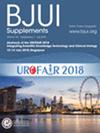主动监测前列腺癌患者的干预措施:叙述性回顾。
IF 4.4
2区 医学
Q1 UROLOGY & NEPHROLOGY
引用次数: 0
摘要
目的探讨支持主动监测(AS)早期前列腺癌(PCa)患者非手术干预的当代证据。方法于2024年1月使用PubMed、Medline和Embase数据库进行文献检索,确定2011年以来发表的相关文章。随机对照试验(RCTs)和队列研究报告了对AS患者PCa的干预措施。几项研究调查了一系列非手术干预措施,从运动和食物补充剂到雄激素受体途径抑制剂(arpi)。最大的arpi随机对照试验显示,arpi在延缓疾病进展为侵袭性PCa方面效果最大,然而,存在毒性、长期肿瘤安全性和死亡率方面的担忧。营养药品、饮食调整和运动似乎耐受性良好,但缺乏大规模随机对照试验对肿瘤有益的证据。一个主要的挑战是由于活检前磁共振成像降低了最低风险疾病的诊断,对进入和退出AS的标准缺乏共识。分子和成像生物标志物可能有助于完善基线风险分层和指导监测期间的监测。结论:目前支持对AS患者进行干预的证据仍主要基于小型前瞻性队列研究或开放标签II期试验。疾病进展风险较高的患者对短期arpi的兴趣越来越大,而营养药品、饮食和运动可能对低风险患者的长期使用有作用。有必要进行大型、高效的随机对照试验,对不同的干预措施进行长期结果测试,并纳入分子和成像生物标志物。本文章由计算机程序翻译,如有差异,请以英文原文为准。
Interventions for patients with prostate cancer on active surveillance: a narrative review.
OBJECTIVE
To examine contemporary evidence supporting non-surgical interventions for patients with early prostate cancer (PCa) on active surveillance (AS).
METHODS
A literature search was conducted using the databases PubMed, Medline, and Embase in January 2024 to identify relevant articles published from 2011 onwards. Randomised controlled trials (RCTs) and cohort studies reporting on interventions in patients with PCa on AS were included.
RESULTS
Several studies have investigated a range of non-surgical interventions, from exercise and food supplements to androgen receptor pathway inhibitors (ARPIs). The largest RCTs of ARPIs have shown the greatest effect in delaying disease progression to aggressive PCa, however, concerns exist around toxicity, long-term oncological safety, and mortality benefit. Nutraceuticals, dietary modifications, and exercise appear to be well tolerated, but evidence of oncological benefit from large-scale RCTs is lacking. A major challenge is the lack of consensus on criteria for entry to and exit from AS as pre-biopsy magnetic resonance imaging reduces diagnosis of the lowest-risk disease. Molecular and imaging biomarkers may help refine baseline risk stratification and guide monitoring during surveillance.
CONCLUSION
Current evidence supporting interventions for patients on AS remains largely based on small prospective cohort studies or open-label phase II trials. There is growing interest in short-term ARPIs for patients at higher risk of disease progression, while nutraceuticals, diet and exercise may have a role for long-term use in lower-risk patients. Large, well-powered RCTs with long-term outcomes testing different interventions and incorporating molecular and imaging biomarkers are warranted.
求助全文
通过发布文献求助,成功后即可免费获取论文全文。
去求助
来源期刊

BJU International
医学-泌尿学与肾脏学
CiteScore
9.10
自引率
4.40%
发文量
262
审稿时长
1 months
期刊介绍:
BJUI is one of the most highly respected medical journals in the world, with a truly international range of published papers and appeal. Every issue gives invaluable practical information in the form of original articles, reviews, comments, surgical education articles, and translational science articles in the field of urology. BJUI employs topical sections, and is in full colour, making it easier to browse or search for something specific.
 求助内容:
求助内容: 应助结果提醒方式:
应助结果提醒方式:


